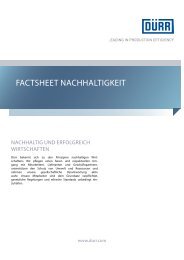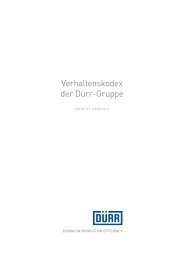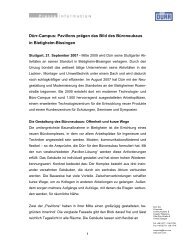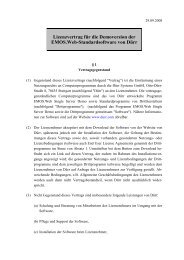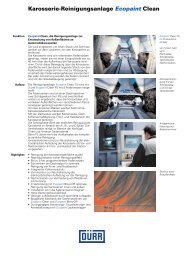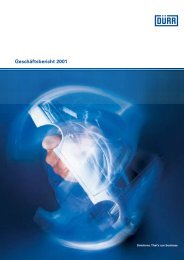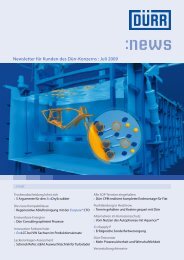Technologies · Systems · Solutions - Dürr
Technologies · Systems · Solutions - Dürr
Technologies · Systems · Solutions - Dürr
Create successful ePaper yourself
Turn your PDF publications into a flip-book with our unique Google optimized e-Paper software.
Credit risk<br />
Currency risk<br />
Interest rate risk<br />
Liquidity risk<br />
Fair value<br />
Consolidated financial statements of <strong>Dürr</strong> AG<br />
All financial derivatives and their underlyings are subject to ongoing and regular internal<br />
119<br />
control and measurement in accordance with a directive of the Board of Management. Derivative<br />
contracts are only entered into with banks with a good credit standing. Interest swaps were<br />
only entered into with German banks.<br />
Derivative financial instruments are only entered into to hedge the operating business.<br />
The credit risk results from the danger that business partners fail to perform their obligation with<br />
primary and derivative financial instruments and that capital losses are incurred as a result.<br />
Credit ratings are performed for all new customers. Existing customers are analyzed regularly<br />
based on their payment behavior.<br />
As we do not conclude any general netting agreements with our customers, the sum of the<br />
amounts reported under assets also represents the maximum credit risk. There is no apparent<br />
concentration of credit risk from exposures to a single debtor or to groups of debtors.<br />
Currency risks exist in particular where receivables or liabilities exist or will arise in the ordinary<br />
course of business in a currency other than the local currency of the Company.<br />
Forward exchange transactions are entered into to hedge against exchange rate fluctuations<br />
from cash flows relating to anticipated purchasing and sales transactions with terms of up<br />
to 18 months.<br />
In the 2004 reporting period, revolving forward exchange transactions were entered into to hedge<br />
against exchange rate fluctuations of intercompany loans with terms of up to one month.<br />
To manage the market risk for changes in interest rates of existing and anticipated variable-rate<br />
liabilities to banks, the Company entered into interest swaps with residual maturities of up<br />
to 14 months.<br />
Unused credit lines at the disposition of the Group ensure that it has sufficient funds.<br />
The financial instruments of the Group not accounted for at fair value mainly consist of cash and<br />
cash equivalents, trade receivables, trade payables and other liabilities, overdraft facilities and<br />
long-term loans.<br />
The carrying value of cash and cash equivalents and of overdraft facilities approximates fair value<br />
due to the highly liquid nature of these instruments.<br />
The fair value of receivables and payables based on the normal credit terms of trade also approximates<br />
their carrying value at historical cost.<br />
The fair value of non-current liabilities is based on the current interest rate for borrowing at similar<br />
terms and conditions with the same due date and credit rating. With the exception of the bond,<br />
the fair value of debt capital corresponds closely to the net carrying amount. As of December 31,<br />
2004, the bond is listed at 108.20% which is equal to a fair value of € 216,400 thousand.<br />
Depending on their fair value on the balance sheet date, derivative financial instruments are<br />
reported under other assets (positive fair value) or other liabilities (negative fair value)<br />
respectively.




